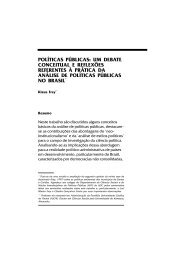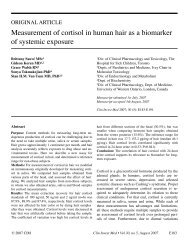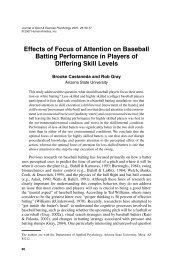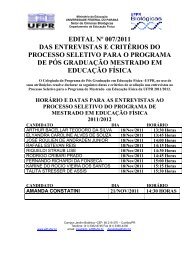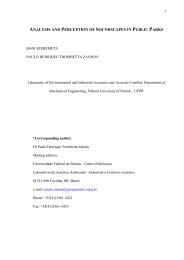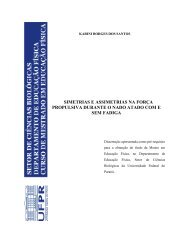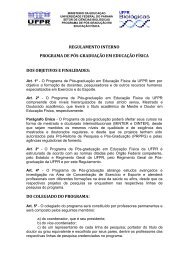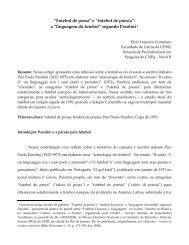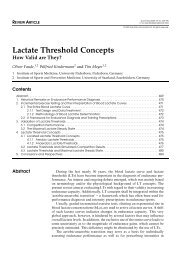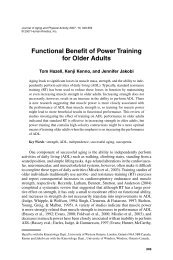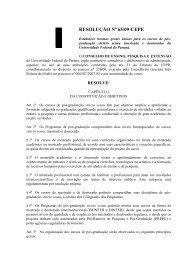Journal of Electromyography and Kinesiology - UFPR
Journal of Electromyography and Kinesiology - UFPR
Journal of Electromyography and Kinesiology - UFPR
Create successful ePaper yourself
Turn your PDF publications into a flip-book with our unique Google optimized e-Paper software.
D.P. LaRoche et al. / <strong>Journal</strong> <strong>of</strong> <strong>Electromyography</strong> <strong>and</strong> <strong>Kinesiology</strong> 20 (2010) 482–488 487<br />
contractions, muscle activation time in the muscles studied is not<br />
strongly associated with a history <strong>of</strong> falls. However, when each<br />
temporal component was summed across muscle groups <strong>and</strong><br />
examined independently, motor time was 22 ms longer (29%) in<br />
fallers. Motor time, the time from nervous activation to torque production,<br />
is longer in less active individuals (Bunce et al., 2004; LaRoche<br />
et al., 2007) <strong>and</strong> it increases with age (Bunce et al., 2004).<br />
Likely, the slowed motor time <strong>of</strong> fallers is representative <strong>of</strong> diminished<br />
excitation–contraction coupling including slowed calcium<br />
release or reuptake from the sarcoplasmic reticulum <strong>and</strong> decreased<br />
activity <strong>of</strong> metabolic enzymes such as creatine kinase <strong>and</strong> actomyosin<br />
ATPase (Prochniewicz et al., 2005; Kaczor et al., 2006; Pastoris<br />
et al., 2000). Alternatively, if fallers had reduced muscle mass <strong>and</strong><br />
cross-sectional area, the slower motor time may have been due to<br />
reduced musculotendinous stiffness that would result in less<br />
immediate transfer <strong>of</strong> force from the muscle to the bone (Magnusson<br />
et al., 1997). In fact, elderly have been shown to have tendons<br />
that are less stiff than young yet have the capacity to increase stiffness<br />
by more than 60% following resistance training (Reeves et al.,<br />
2003). It is therefore logical that the longer motor time seen in elderly<br />
fallers covaries with reduced strength.<br />
4.4. Muscle EMG activity<br />
Because aging (LaRoche et al., 2008; Laughton et al., 2003) <strong>and</strong><br />
low levels <strong>of</strong> physical activity (LaRoche et al., 2007) have been<br />
associated with decreased neural drive, it was hypothesized that<br />
decreased agonist activation might contribute to the lower<br />
strength <strong>and</strong> rate <strong>of</strong> torque development seen in older female fallers.<br />
Unexpectedly, the magnitude <strong>of</strong> neuromuscular activation <strong>of</strong><br />
the agonist muscles in the first 200 ms <strong>of</strong> contraction was not different<br />
between fallers <strong>and</strong> nonfallers for any <strong>of</strong> the actions performed.<br />
Also, it was hypothesized that greater levels <strong>of</strong><br />
antagonist coactivation in older female fallers might contribute<br />
to reduced net joint torque, slowed movements, <strong>and</strong> their inability<br />
to appropriately respond to postural disturbances but this too was<br />
not supported by the current study. These findings indicate that in<br />
this group <strong>of</strong> women, when performing simple, single joint<br />
strength tasks, that performance <strong>of</strong> the motor system does not distinguish<br />
between fallers <strong>and</strong> nonfallers.<br />
4.5. Limitations<br />
A major limitation <strong>of</strong> this study was that it was cross-sectional<br />
in nature <strong>and</strong> did not prospectively determine the relationship between<br />
neuromuscular performance <strong>and</strong> fall risk. A significant<br />
health disparity was identified between fallers <strong>and</strong> nonfallers with<br />
fallers reporting more medication use, arthritis, pain, <strong>and</strong> fatigue.<br />
Because <strong>of</strong> the study design, it is not possible to differentiate to<br />
what extent the neuromuscular performance deficits or impaired<br />
general health contributed to the greater history <strong>of</strong> falls. Lastly,<br />
the performance <strong>of</strong> the hip musculature was not assessed in this<br />
study despite its documented importance in recovery from loss<br />
<strong>of</strong> balance (Thelen et al., 2000).<br />
5. Conclusions<br />
This study indicates that poor health <strong>and</strong> poor muscular fitness<br />
are comorbid conditions likely to be seen in elderly fallers. This was<br />
demonstrated by diminished lower extremity strength <strong>and</strong> a higher<br />
prevalence <strong>of</strong> non-muscular fall risk factors in older female fallers.<br />
The results suggest that strength, speed <strong>of</strong> movement, <strong>and</strong> power <strong>of</strong><br />
the ankle dorsiflexors <strong>and</strong> plantarflexors should be further studied<br />
as potential contributors to falls in older adults. Secondly, interventions<br />
designed to reduce falls might help control the number <strong>and</strong><br />
type <strong>of</strong> medication use, as well as reduce fatigue, stress <strong>and</strong> chronic<br />
pain. Finally, the determination <strong>of</strong> specific muscular weaknesses<br />
<strong>and</strong> fall risk factors should be used to design individualized fall prevention<br />
programs that are likely to be more successful than generalized<br />
fall prevention programs (Tinetti et al., 1994).<br />
Financial disclosure<br />
We certify that no party having a direct interest in the results <strong>of</strong><br />
the research supporting this article has or will confer a benefit on<br />
us or on any organization with which we are associated AND, if<br />
applicable, we certify that all financial <strong>and</strong> material support for this<br />
research (e.g., NIH or NHS grants) <strong>and</strong> work are clearly identified in<br />
the title page <strong>of</strong> the manuscript.<br />
Conflict <strong>of</strong> interest<br />
None.<br />
References<br />
AGS. Guideline for the prevention <strong>of</strong> falls in older persons. American Geriatrics<br />
Society, British Geriatrics Society, <strong>and</strong> American Academy <strong>of</strong> Orthopaedic<br />
Surgeons Panel on Falls Prevention. J Am Geriatr Soc 2001;49(5):664–72.<br />
Ainsworth BE, Haskell WL, Leon AS, Jacobs Jr DR, Montoye HJ, Sallis JF, et al.<br />
Compendium <strong>of</strong> physical activities: classification <strong>of</strong> energy costs <strong>of</strong> human<br />
physical activities. Med Sci Sports Exerc 1993;25(1):71–80.<br />
Bean JF, Kiely DK, Herman S, Leveille SG, Mizer K, Frontera WR, et al. The<br />
relationship between leg power <strong>and</strong> physical performance in mobility-limited<br />
older people. J Am Geriatr Soc 2002;50(3):461–7.<br />
Bunce D, MacDonald SW, Hultsch DF. Inconsistency in serial choice decision <strong>and</strong><br />
motor reaction times dissociate in younger <strong>and</strong> older adults. Brain Cogn<br />
2004;56(3):320–7.<br />
Campbell AJ. Falls, fractures <strong>and</strong> drugs. N Z Med J 1990;103(903):580–1.<br />
Close JC, Hooper R, Glucksman E, Jackson SH, Swift CG. Predictors <strong>of</strong> falls in a high<br />
risk population: results from the prevention <strong>of</strong> falls in the elderly trial (PROFET).<br />
Emerg Med J 2003;20(5):421–5.<br />
Cranwell-Bruce LA. The connection between patient falls <strong>and</strong> medication. Medsurg<br />
Nurs 2008;17(3):189–91. quiz 92.<br />
D’Antona G, Pellegrino MA, Carlizzi CN, Bottinelli R. Deterioration <strong>of</strong> contractile<br />
properties <strong>of</strong> muscle fibres in elderly subjects is modulated by the level <strong>of</strong><br />
physical activity. Eur J Appl Physiol 2007;100(5):603–11.<br />
Fozard JL, Vercryssen M, Reynolds SL, Hancock PA, Quilter RE. Age differences <strong>and</strong><br />
changes in reaction time: the Baltimore longitudinal study <strong>of</strong> aging. J Gerontol<br />
1994;49(4):P179–89.<br />
Hakkinen K, Hakkinen A. Muscle cross-sectional area, force production <strong>and</strong><br />
relaxation characteristics in women at different ages. Eur J Appl Physiol<br />
Occup Physiol 1991;62(6):410–4.<br />
Heesch KC, Miller YD, Brown WJ. Relationship between physical activity <strong>and</strong> stiff or<br />
painful joints in mid-aged women <strong>and</strong> older women: a 3-year prospective<br />
study. Arthritis Res Ther 2007;9(2):R34.<br />
Kaczor JJ, Ziolkowski W, Antosiewicz J, Hac S, Tarnopolsky MA, Popinigis J. The effect<br />
<strong>of</strong> aging on anaerobic <strong>and</strong> aerobic enzyme activities in human skeletal muscle. J<br />
Gerontol A Biol Sci Med Sci 2006;61(4):339–44.<br />
Kemoun G, Thoumie P, Boisson D, Guieu JD. Ankle dorsiflexion delay can predict<br />
falls in the elderly. J Rehabil Med 2002;34(6):278–83.<br />
Kerrigan DC, Todd MK, Della Croce U, Lipsitz LA, Collins JJ. Biomechanical gait<br />
alterations independent <strong>of</strong> speed in the healthy elderly: evidence for specific<br />
limiting impairments. Arch Phys Med Rehabil 1998;79(3):317–22.<br />
Kostka T. Quadriceps maximal power <strong>and</strong> optimal shortening velocity in 335 men<br />
aged 23–88 years. Eur J Appl Physiol 2005;95(2–3):140–5.<br />
Kriska AM, Knowler WC, LaPorte RE, Drash AL, Wing RR, Blair SN, et al. Development<br />
<strong>of</strong> questionnaire to examine relationship <strong>of</strong> physical activity <strong>and</strong> diabetes in<br />
Pima Indians. Diabetes Care 1990;13(4):401–11.<br />
Lanza IR, Towse TF, Caldwell GE, Wigmore DM, Kent-Braun JA. Effects <strong>of</strong> age on<br />
human muscle torque, velocity, <strong>and</strong> power in two muscle groups. J Appl Physiol<br />
2003;95(6):2361–9.<br />
LaRoche DP, Knight CA, Dickie JL, Lussier MV, Roy SJ. Explosive force <strong>and</strong><br />
fractionated reaction time in elderly low <strong>and</strong> high active women. Med Sci<br />
Sports Exerc 2007;39(9):1659–65.<br />
LaRoche DP, Roy SJ, Knight CA, Dickie JL. Elderly women have blunted response to<br />
resistance training despite reduced antagonist coactivation. Med Sci Sports<br />
Exerc 2008;40:1660–8.<br />
Larsson L, Grimby G, Karlsson J. Muscle strength <strong>and</strong> speed <strong>of</strong> movement in relation<br />
to age <strong>and</strong> muscle morphology. J Appl Physiol 1979;46(3):451–6.<br />
Laughton CA, Slavin M, Katdare K, Nolan L, Bean JF, Kerrigan DC, et al. Aging, muscle<br />
activity, <strong>and</strong> balance control: physiologic changes associated with balance<br />
impairment. Gait Posture 2003;18(2):101–8.<br />
Lipsitz LA, Jonsson PV, Kelley MM, Koestner JS. Causes <strong>and</strong> correlates <strong>of</strong> recurrent<br />
falls in ambulatory frail elderly. J Gerontol 1991;46(4):M114–22.



